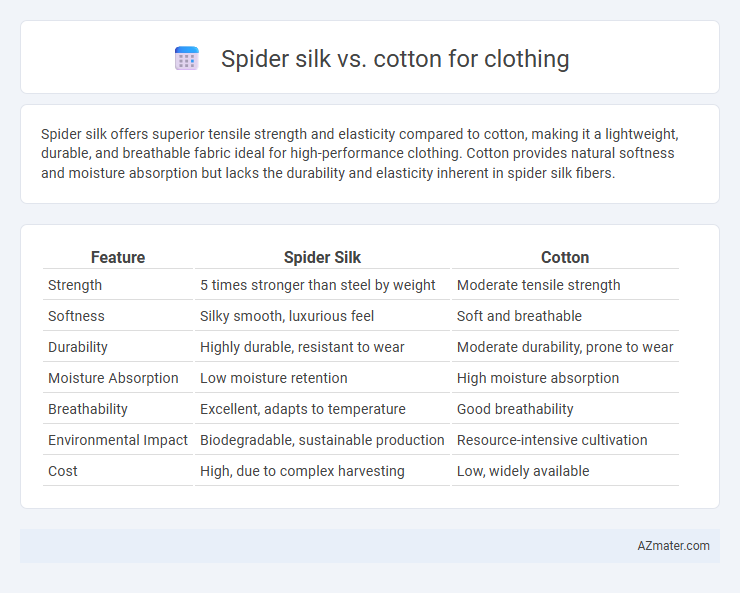Spider silk offers superior tensile strength and elasticity compared to cotton, making it a lightweight, durable, and breathable fabric ideal for high-performance clothing. Cotton provides natural softness and moisture absorption but lacks the durability and elasticity inherent in spider silk fibers.
Table of Comparison
| Feature | Spider Silk | Cotton |
|---|---|---|
| Strength | 5 times stronger than steel by weight | Moderate tensile strength |
| Softness | Silky smooth, luxurious feel | Soft and breathable |
| Durability | Highly durable, resistant to wear | Moderate durability, prone to wear |
| Moisture Absorption | Low moisture retention | High moisture absorption |
| Breathability | Excellent, adapts to temperature | Good breathability |
| Environmental Impact | Biodegradable, sustainable production | Resource-intensive cultivation |
| Cost | High, due to complex harvesting | Low, widely available |
Introduction: Spider Silk and Cotton in Clothing
Spider silk offers exceptional tensile strength, elasticity, and lightweight properties, making it a highly durable and flexible material for clothing compared to cotton. Cotton, a natural fiber derived from the cotton plant, is widely valued for its breathability, softness, and moisture absorption. The combination of spider silk's superior mechanical properties and cotton's comfort highlights distinct advantages in textile innovation and performance apparel.
Material Origins: Spider Silk vs Cotton
Spider silk, produced by spiders through protein-based natural fibers, offers exceptional strength and elasticity compared to cotton, which is derived from the cellulose fibers of cotton plants. While cotton is a widely cultivated plant fiber known for its breathability and comfort, spider silk's protein composition provides superior durability and moisture-wicking properties. Advances in biotechnology have enabled the production of synthetic spider silk, enhancing the feasibility of spider silk textiles in clothing applications versus traditional cotton fabrics.
Physical Properties Comparison
Spider silk exhibits superior tensile strength and elasticity compared to cotton, making it highly durable and resistant to tearing. Its fine fibers offer exceptional softness and moisture-wicking capabilities, enhancing comfort and breathability in clothing. Cotton, while breathable and widely used, lacks the remarkable strength and stretchability inherent to spider silk, resulting in less durability over time.
Strength and Durability: Head-to-Head
Spider silk outperforms cotton in strength, boasting tensile strength comparable to steel while being significantly lighter, making it exceptionally durable for clothing applications. Cotton fibers lack the same resilience and break down faster under stress and repeated wear, limiting their lifespan in garments. The molecular structure of spider silk, with its unique protein chains, provides superior elasticity and toughness, ensuring longer-lasting fabrics compared to traditional cotton textiles.
Comfort and Wearability Factors
Spider silk offers superior softness and breathability compared to cotton, enhancing comfort for extended wear. Its natural elasticity allows garments to maintain shape and provide better fit, reducing discomfort caused by fabric strain. Cotton, while widely used, tends to retain moisture and lacks the same level of stretch, often leading to less comfort in humid or active conditions.
Moisture Wicking and Breathability
Spider silk outperforms cotton in moisture-wicking due to its unique protein structure, which actively pulls sweat away from the skin while maintaining a dry feel. Its natural breathability surpasses cotton by allowing superior air circulation, making garments more comfortable in both hot and humid conditions. Unlike cotton, spider silk resists moisture retention, reducing odor formation and accelerating drying times for enhanced wearability.
Sustainability and Environmental Impact
Spider silk outperforms cotton in sustainability due to its biodegradability, low resource requirements, and zero pesticide use. Cotton cultivation demands extensive water, synthetic fertilizers, and pesticides, contributing to soil degradation and pollution. Spider silk's minimal environmental footprint makes it a superior choice for eco-friendly clothing production.
Production Challenges and Scalability
Spider silk offers exceptional strength and elasticity compared to cotton, but its production faces significant challenges due to spiders' territorial and cannibalistic nature, complicating large-scale farming. Synthetic biology advancements enable scalable spider silk protein production using microbial fermentation, yet the process remains costly and energy-intensive compared to conventional cotton cultivation. Cotton benefits from established large-scale agriculture with efficient harvesting and processing systems, but it requires substantial water and pesticide inputs, contrasting with the potential sustainability of lab-produced spider silk fibers.
Cost and Accessibility for Consumers
Spider silk, known for its exceptional strength and elasticity, remains significantly more expensive than cotton due to complex production methods and limited scalability. Cotton benefits from widespread agricultural infrastructure, making it highly accessible and affordable for consumers worldwide. While synthetic spider silk alternatives are emerging, cotton continues to dominate the market because of its cost-effectiveness and availability.
Future Prospects in Fashion Industry
Spider silk offers remarkable strength, elasticity, and biodegradability, positioning it as a sustainable alternative to traditional cotton in the fashion industry. Innovations in bioengineering and synthetic spider silk production are driving scalability, making spider silk garments more accessible and environmentally friendly. As consumer demand shifts towards eco-conscious materials, spider silk is poised to revolutionize apparel with superior durability and reduced environmental impact compared to conventional cotton fabrics.

Infographic: Spider silk vs Cotton for Clothing
 azmater.com
azmater.com